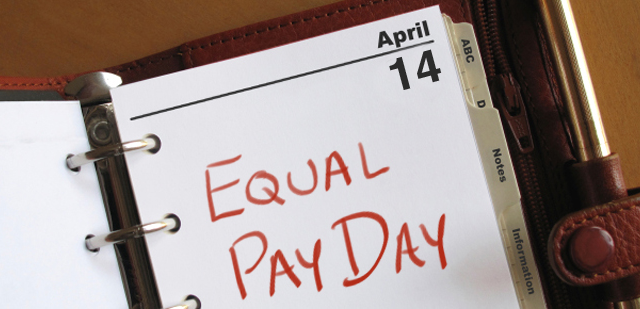Equal Pay Day is April 14 this year, the day when the paychecks of American women finally catch up to the amounts their male counterparts earned in calendar 2014. Women make up more than half the workforce and are a critical part of the 21st-century economy, yet their paychecks rarely reflect that.
Each year for Equal Pay Day, the American Association of University Women (AAUW) puts out an updated version of The Simple Truth, based on data released by the U.S. Census Bureau at the beginning of the year. The booklet outlines actions governments, employers, and individuals can take to help solve this systemic problem, such as passing fair pay legislation, providing transparency in pay systems, and negotiating salaries.
The Simple Truth in 2015 is that the pay gap has barely budged in a decade. Women in every state experience the pay gap, but some states are worse than others. The best place in the United States for pay equity is Washington, D.C., where women were paid 91 percent of what men were paid in 2013. At the other end of the spectrum is Louisiana, the worst state in the country for pay equity, where women were paid just 66 percent of what men were paid. The gender wage gap in NY stands at 86 percent.
The pay gap is worse for women of color. The gender pay gap affects all women, but for women of color the pay shortfall is worse. Asian American women’s salaries show the smallest gender pay gap, at 90 percent of white men’s earnings. The wage gap for African-American women is 64 percent. Hispanic women’s salaries show the largest gap, at 54 percent of white men’s earnings.
Women face a pay gap in nearly every occupation. From elementary and middle school teachers to computer programmers, women are paid less than men in female-dominated, gender-balanced, and male-dominated occupations.
The pay gap grows with age. Women typically earn about 90 percent of what men are paid until they hit 35. After that median earnings for women are typically 75–80 percent of what men are paid.
And while more education is an effective tool for increasing earnings, it is not an effective tool against the gender pay gap. At every level of academic achievement, women’s median earnings are less than men’s earnings, and in some cases, the gender pay gap is larger at higher levels of education.
The pay gap also exists among women without children. AAUW’s Graduating to a Pay Gap found that among full-time workers one year after college graduation — nearly all of whom were childless — women were paid just 82 percent of what their male counterparts were paid.
Equal pay for equal work is more critical than ever since more women are now the primary or co-breadwinners of their families. The pay gap increases with a woman’s age, leaving the average woman $800,000 short by the time she is 65. The short and long term economic effect of the pay gap on the lives of women and their families is staggering.
“The simple truth is that the economic contributions of women are often undervalued and underpaid,” said AAUW-NYS’s vice president for Public Policy, Donna Seymour, Potsdam. “Fair and equal pay is critical for women and their families. Economists now worry having a job may no longer be enough for self-sufficiency today, as the middle class shrinks and low-wage jobs become the new normal,” she added.
And at the rate the pay gap is failing to close, the next generation of American women won’t earn fair and equal pay for another 45 years. Our daughters (and their families) shouldn’t have to wait 45 years for get equal pay for equal work.
“The sting of gender pay discrimination is real – at the grocery store, at the gas station, and in retirement,” said Seymour. “We know that women are far more likely to spend their golden years in poverty and that it starts the moment we throw our graduation caps in the air. Women’s wages should be determined by the work we do rather than influenced by outdated and discriminatory gender stereotypes. It’s time for our paychecks and state and national policy to catch up to the 21st century.”
Photo credit: http://www.aauw.org


